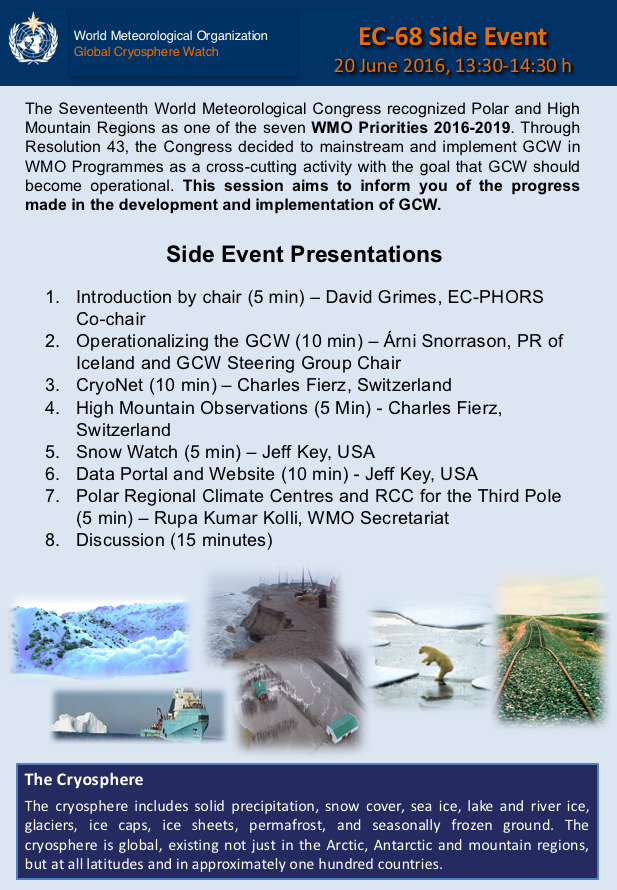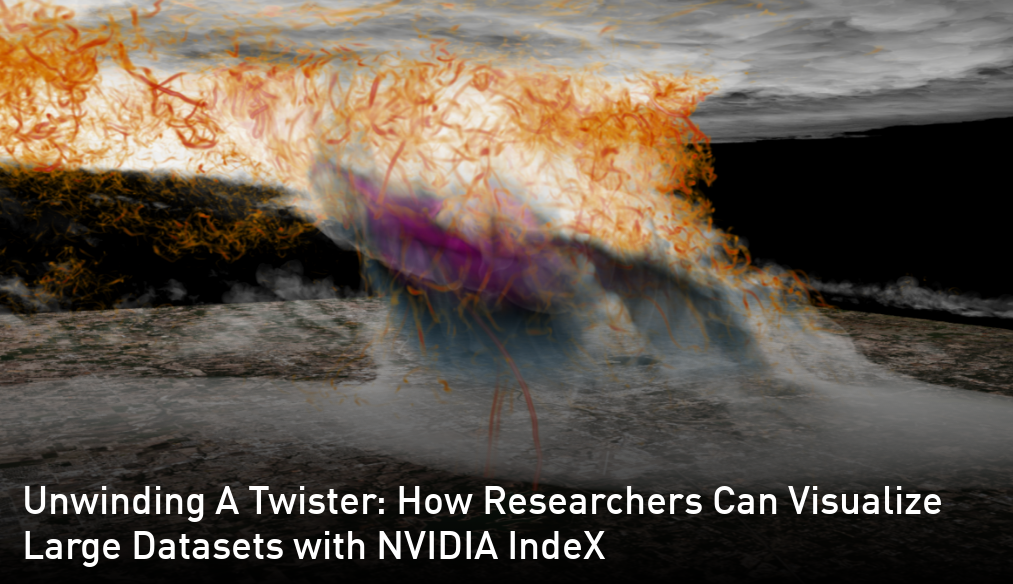
[ Archive ]

 |
CIMSS-NOAA Weekly Report
[ Archive ] |
 |
IN THE PRESS:
ITEMS FOR THE ADMINISTRATOR:
ITEMS FOR THE ASSISTANT ADMINISTRATOR:
ITEMS FOR THE OFFICE DIRECTOR, STAR:
GCW Side Event at WMO Executive Council Meeting: The World Meteorological Organization (WMO) held its 68th Executive Council (EC) meeting in Geneva, Switzerland. The WMO Global Cryosphere Watch (GCW) program held a side event on June 20, 2016, for EC Members. The purpose was to inform the Members of GCW's progress over the past year, in preparation for the formal consideration of GCW's status and progress by EC the following day. The side event was chaired and introduced by WMO President Dr. David Grimes. Árni Snorrason, head of the Icelandic Meteorological Office and Chair of the GCW Steering Group, discussed the operational implementation of GCW. Charles Fierz, president of the International Association of Cryospheric Scientists (IACS), presented the GCW surface network, called CryoNet, and high mountain observations. Jeff Key, NOAA and one of the side event organizers, presented accomplishments of the Snow Watch, Portal, and Website teams. Rupa Kumar Kolli, WMO Secretariat, finished the session with a presentation on Polar Regional Climate Centres. (J. Key, E/RA2, 608-263-2605, jkey@ssec.wisc.edu)
 (Click image to enlarge)
(Click image to enlarge)
Manuscript on Marine Aerosols in the Equatorial Pacific Published in ACP: A manuscript entitled “Contribution of dissolved organic matter to submicron water-soluble organic aerosols in the marine boundary layer over the eastern equatorial Pacific” was published in Atmospheric Chemistry and Physics (Miyazaki, Y., Coburn, S., Ono, K., Ho, D. T., Pierce, R. B., Kawamura, K., and Volkamer, R., Atmos. Chem. Phys., 16, 7695-7707, doi:10.5194/acp-16-7695-2016, 2016). The study used ship based measurements collected during the Tropical Ocean tRoposphere Exchange of Reactive halogens and Oxygenated VOCs (TORERO) field campaign to show that marine dissolved organic matter is a significant source of marine aerosols in the eastern equatorial Pacific. The study utilized trajectory analysis from the Real-time Air Quality Modeling System (RAQMS) to characterize the source of the observed aerosols (R.B. Pierce, E/RA2, 608-890-1892, brad.pierce@noaa.gov)
Paper on VIIRS Ice Concentration Published: A paper titled "Sea and Freshwater Ice Concentration from VIIRS on Suomi NPP and the Future JPSS Satellites", by Yinghui Liu (Cooperative Institute for Meteorological Satellite Studies), J. Key (NOAA/STAR), and R. Mahoney (Northrop Grumman), was published in the journal Remote Sensing this week (http://www.mdpi.com/2072-4292/8/6/523, doi:10.3390/rs8060523). The paper describes the JPSS Enterprise algorithm for estimating sea ice and freshwater ice concentration. (Y. Liu, CIMSS, 608-265-8620; J. Key, E/RA2, 608-263-2605, jkey@ssec.wisc.edu)
2016 Midwest and Central States Air Quality Workshop: Brad Pierce attended the 2016 Midwest and Central States Air Quality Workshop in St. Louis, MO on June 21-23, 2016 and presented a talk entitled “AQAST NOAA/NESDIS liaison highlights and planning for a future Great Lakes airborne mission” in the session on characterizing local to regional pollution sources and a talk entitled “Satellite data, modeling, and planned field study for better characterizing wildfire impacts (FIREX)” in the session on fires, stratospheric ozone, & international contributions to US pollution. The workshop was sponsored by the Central States Air Resource Agencies (CenSARA), Lake Michigan Air Directors Consortium (LADCO) and the US Environmental Protection Agency (EPA) Office of Air Quality Planning and Standards (OAQPS) and brought together air quality researchers who have a focus on the central and midwestern portions of the U.S., technical state agency staff, and federal regulatory agency staff to share current research, methodologies, and projects (R.B. Pierce, E/RA2, 608-890-1892, brad.pierce@noaa.gov)
NVIDIA uses CIMSS Tornado Data to Showcase New Software and Hardware: Interactive volume rendering software, efficiently utilizing GPUs, can serve as a useful tool for researchers trying to make sense of terabytes of data. Cooperative Institute for Meteorological Satellite Studies (CIMSS) Associate Scientist Leigh Orf has been working with NVIDIA to evaluate the usefulness of new interactive volume rendering software by supplying large volumes of simulated supercell data and guiding developers on identifying scientifically interesting features in the data. A blog entry summarizes this at https://blogs.nvidia.com/blog/2016/06/19/unwinding-twister-researchers-can-visualize-large-datasets-nvidia-index-paraview/. (L. Orf, CIMSS, 608-890-1983)
 (Click image to enlarge)
(Click image to enlarge)
Figure caption: NVIDIA demonstrates their interactive visualization software utilizing simulated thunderstorm data created by CIMSS Associate Scientist Leigh Orf.
ITEMS FOR THE DIVISION CHIEF, CoRP:
Training Seminar on ProbSevere Model: A 60-minute training seminar on the ProbSevere model was conducted with the National Weather Service (NWS) Western Region Science and Operations Officers (SOO’s). Mike Pavolonis (NOAA/NESDIS/STAR) led the seminar. ProbSevere, which was developed by STAR in close collaboration with the Cooperative Institute for Meteorological Satellite Studies (CIMSS), calculates the probability that a given developing thunderstorm will produce severe weather up to 60 minutes in the future. The NWS Western Region, which consists of 24 Weather Forecast Offices (WFO’s), recently started using ProbSevere in severe weather warning operations. ProbSevere has been shown to help extend the lead time of severe weather warnings. (M. Pavolonis, E/RA2, 608-263-9597, Mike.Pavolonis@noaa.gov)
CIMSS Scientist Presents Tornado Research Results at Supercomputing Seminar: Associate Scientist Leigh Orf gave a 25 minute presentation at the fourth annual Blue Waters Symposium in Sunriver, Oregon. This presentation summarizes recent numerical modeling efforts on the Blue Waters Supercomputer, including a recent 20 meter resolution supercell simulation that produces a multiple-vortex EF5-strength tornado. The entire talk is available in video form at https://youtu.be/8Prk_TT1CsE. (L. Orf, CIMSS, 608-890-1983)
VISITORS:
Dr. Marouane Temimi Visits from Masdar Institute, United Arab Emirates: Associate Professor Marouane Temimi of the Masdar Institute of Science and Technology, United Arab Emirates (UAE), presented at a seminar titled "Environmental monitoring and modeling through the integration of remote sensing data in arid regions" on June 21, 2016 at the Cooperative Institute for Meteorological Satellite Studies (CIMSS). The goal of the presentation was to showcase the potential of satellite imagery for environmental monitoring particularly in studying hydrological and atmospheric processes as well as changes in land surface conditions especially in the UAE and arid regions. The focus is also put on examples of developed applications and products that are useful for decision making to enhance contingency planning and response to natural disasters. During the visit, he discussed possible satellite decision support product collaborations and how SEVIRI data may be better utilized to monitor fog/low cloud conditions at airports servicing the UAE and how satellite inferred aerosol optical depth could be forecast which heavily impacts the health of the population. A follow up visit to the UAE was discussed to further explore collaborations between UW-Madison SSEC/CIMSS and the UAE decision weather support needs. (W. Feltz, CIMSS, 608-265-6283)
NEXT WEEK:
LOOKING AHEAD:
| Archived Weeklies Page | Submit a report item |